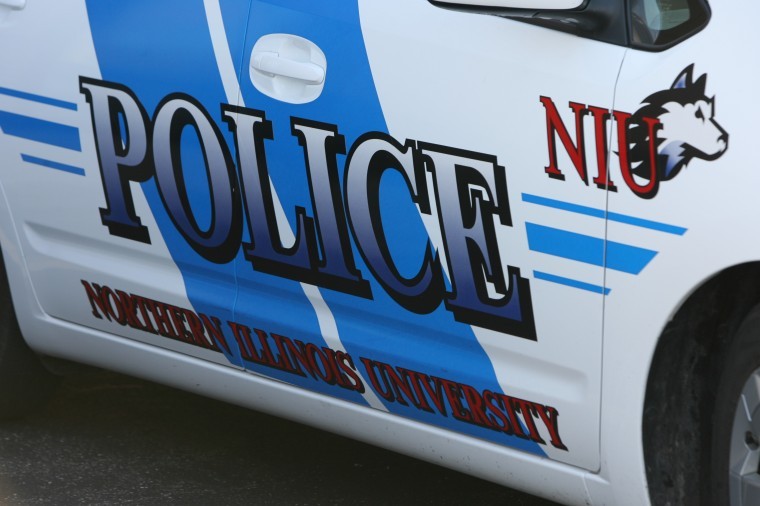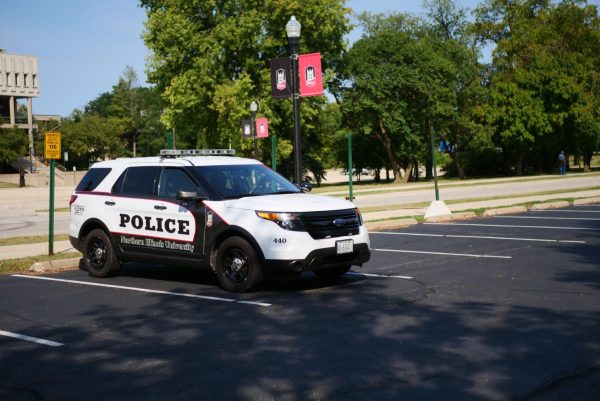Serious crime concerns are not unique to NIU campus
NIU Police Department will have 14 unarmed security guards. These security personnel will operate as foot-patrol security guards for the NIU campus and in the immediate vicinity where many students live.
November 17, 2010
In the weeks since the disappearance and murder investigation of NIU freshman Antinette “Toni” Keller, campus safety and security has been a concern for NIU students and the surrounding community.
In a letter sent home to parents and family members of NIU students on Nov. 3, NIU President John Peters assured parents that NIU is committed to providing a safe environment for students, but not all students feel at ease.
Kate Meehan, sophomore speech language pathology major, said she is transferring to the University of Illinois next semester because of her parents’ safety concerns.
“I don’t think [my mom] thinks [NIU] is very safe,” Meehan said.
After the arrest of William P. Curl, the man charged with Keller’s murder, students still had concerns.
“I feel safe knowing that they’re doing something about it,” said Brittany Anderson, freshman business administration major, in an Oct. 31 Northern Star article. “But I don’t really feel safer knowing that he’s in custody.”
The Keller investigation has garnered national media attention, but serious crime and safety concerns are not unique to the NIU campus.
The University of Illinois at Urbana-Champaign, UIUC, has recently had incidences of “peeping Toms,” assaults on student pedestrians and a midday sexual assault on a female student in one of its residence hall showers, according to a Nov. 14 article in The Daily Illini, UIUC student newspaper.
Students and parents expressed concerns about on-campus living during a town hall meeting with UIUC officials on Nov. 13. Attendees complained about too few self-defense classes, multiple unsecured entrances to residence halls and that non-residents can access residence hall elevators.
Though UIUC Chief of Police Barbara O’Connor said over 25 arrests have been made in connection with the recent assaults, the police have not gained any information that would be useful in preventing similar crime, according to The Daily Illini article.
Concerned parents and students at UIUC and NIU aren’t alone in feeling there is a lack of safety on their campuses. Western Illinois University officials also held a town hall meeting on Nov. 11 to address five recent bomb threats, according to a Nov. 12 article in the Western Courier, WIU’s student newspaper.
According to the article, some students who attended the meeting considered leaving campus. Kenneth Hawkinson, WIU associate provost for budget, planning and personnel, urged students to stay on campus and continue their routines as usual.
The editorial board of the Daily Vidette, Illinois State University student newspaper, requested for increased residence hall security similar to the policy recently enacted at UIUC, in a Nov. 11 editorial.
“In light of recent crimes across other campuses, dorm security should be addressed in the interest of safety of all students in the residence halls,” said the Daily Vidette Editorial Board in the article.
Ohio State University received an anonymous bomb threat Tuesday and had to close down four buildings on campus to search for suspicious packages, according to The Lantern, OSU’s student newspaper.
University Crime Comparison
The Northern Star has compiled crime statistics from seven different universities, including NIU, using their 2009 Clery Annual Campus Security Reports. The Clery Act requires every university that receives federal financial aid to release information about the university’s police department and annual crime statistics.
Seven public state universities were chosen to compare the crime statistics: University of Wisconsin-Madison, University of Illinois-Urbana/Champaign, Northern Illinois University-DeKalb, Illinois State University-Bloomington/Normal, Southern Illinois University-Carbondale, Western Illinois University-Macomb and Eastern Illinois University-Charleston.
The Clery Report discloses information on several different kinds of crime from the past three years, but this article will address the eight crimes that are indicative of safety on campus: forcible sex offenses, aggravated assault, burglary, liquor law violation arrests and referrals, drug law violation arrests and referrals and murder or negligent manslaughter. To compare schools, the universities’ total enrollment were also taken into consideration.
In order to better analyze the statistics, the Northern Star divided the number of total crimes in 2009 by the total enrollment number. This will show the crimes per student and provide a better image of which campus fared best statistically.
The numbers report that ISU, with .11 crimes committed per student, is the least safe campus surveyed. WIU is in a close second place, with .10 crimes committed per student. The crimes committed per student statistic declines slowly after WIU.
UW has .08, EIU comes next with .06 and SIU comes down to .04 crimes committed per student. The statistics show that UIUC and NIU have the same .03 crimes committed per student. According to the statistics, UIUC and NIU are the safest campuses while ISU is the least safe.
More Than Numbers
Although the numbers report that ISU is the least safe, most police officers say that statistics aren’t the best way to define a safe campus.
“I don’t think someone can use purely statistics,” said UW Patrol Sgt. Aaron Chapin. “It doesn’t give a full picture.”
Other university police officials have thoughts that align with Chapin.
Todd Sigler, director of the SIU Department of Public Safety, said the definition of a safe campus is based on more than just numbers – it is a relationship between the community and the department.
“A safe campus is an area where students, staff, faculty and visitors can complete their missions,” Chapin said.
In interviews with police officials responsible for the campuses surveyed, most said campus safety can be defined as a good working relationship between the police department and the students, faculty and staff on campus.
“I think one of the biggest things is the sense of community,” said Jeff Christensen, UIUC Deputy Chief of Police. “The police obviously can’t do it all on our own, we need help from the community.”
Sigler said he agrees with Christensen and thinks that “a culture that encourages reporting crimes” is key to making a campus safe.
“As [the police department] gets to know the community, we can decrease crime,” said NIU Police Sgt. Alan Smith.
Smith also said keeping a safe campus can come down to how well-trained the officers are.
“When something happens, you fall back on your training,” Smith said.
Besides training and the relationship between the community and police department, there are other factors that make a campus safer.
“One of the biggest factors is location,” said EIU Chief of Police Adam Due.
Due said EIU is located in rural Charleston, which can have a positive effect on the overall safety on campus, but knows this is not a concrete defense.
“Crime can happen anywhere,” he said.
The size and type of the university can also affect the overall safety of a college campus, said Aaron Woodruff, ISU Chief of Police, via e-mail.
The larger the campus population and can affect how efficient a police department can patrol the area. Campus safety is also affected if the university has a commuter or traditional campus.
Perception of Safety
Smith said he feels crime and security is also subjective to individual feelings of safety.
“The biggest factor is perception,” Smith said. “No matter what the numbers say, it’s perception.”
According to a June 2010 study by the Illinois Criminal Justice Information Authority, students’ fear of crime and perception of risk is relatively low across Illinois college campuses. The researchers defined the fear of crime as an emotional reaction and the perceptions of risk as the possibility of being the victim of a crime.
The study surveyed over 5,000 students from six Illinois college campuses about the perception of campus safety. The colleges surveyed were three large public four-year universities, a large community college, as well as a large and small private, not-for-profit university.
The study reports that students perceive themselves to be at a greater risk for crime if they have been the victim of a crime in the last 12 months. Female, younger, minority, single and unemployed students were more fearful of crime, according to the study.
Students perceived themselves as capable of handling an emergency situation. They also perceived campus faculty and staff as capable of handling crises, but were more confident in their own abilities. The study also notes that just because students perceive they can handle a crisis situation does not make that true.
The study reports students were “generally supportive” of the major preventative measures that have been taken in the past three years on their college campuses in response to Virginia Tech April 16, 2007 shootings and the NIU Feb. 14, 2008 shootings.
Crime Prevention Tactics
Regardless of the study’s findings that students perceptions of safety are relatively low, the idea of a safe campus is always up for debate. The statistics, police officials and students all have different ideas of a safe campus. University police departments, however, use a variety of tactics to make a community as safe as possible.
EIU does regular patrols of campus and has night assistance – students who patrol residence halls and are in radio contact with police, Due said.
“We rely on good students, staff and community to report suspicious behavior,” Due said. “They are extra eyes and ears for us.”
Chapin said the responsibility of campus safety falls on everyone’s shoulders.
“[The police] can’t be everywhere… students need to take ownership of responsibility for a safe campus,” Chapin said.
|
Crimes per student ranking |
|
| ISU | 0.11 |
| WIU | 0.10 |
| UW | 0.08 |
| EIU | 0.06 |
| SIU | 0.04 |
| NIU | 0.03 |
| UIUC | 0.03 |
| Type of crime | |||
| University of Wisconsin (UW)- Madison | 49,099 students | ||
| 2007 | 2008 | 2009 | |
| Forcible sex offenses | 7 | 5 | 4 |
| Aggravated assault | 11 | 4 | 9 |
| Burglary | 167 | 56 | 83 |
| Liquor law violations (arrest) | 827 | 937 | 827 |
| Liquor law violations (referrals) | 599 | 898 | 2,738 |
| Drug law violations (arrest) | 53 | 48 | 56 |
| Drug law violations (referrals) | 42 | 61 | 202 |
| Murder/non-negligent manslaughter | 0 | 0 | 0 |
| Total | 1706 | 2009 | 3919 |
| # of crimes/ # of students |
0.08 |
| Type of crime | |||
| Northern Illinois University |
22,424 students |
||
| 2007 | 2008 | 2009 | |
| Forcible sex offenses | 17 | 11 | 8 |
| Aggravated assault | 7 | 10 | 12 |
| Burglary | 66 | 46 | 7 |
| Liquor law violations (arrest) | 37 | 34 | 58 |
| Liquor law violations (referrals) | 440 | 247 | 356 |
| Drug law violations (arrest) | 36 | 42 | 46 |
| Drug law violations (referrals) | 40 | 73 | 110 |
| Murder/non-negligent manslaughter | 0 | 5 | 0 |
| Total | 643 | 468 | 597 |
| # of crimes/ # of students |
0.03 |
| Type of crime | |||
| Illinois State University (ISU)- Bloomington/Normal | 20,762 students | ||
| 2007 | 2008 | 2009 | |
| Forcible sex offenses | 0 | 0 | 0 |
| Aggravated assault | 2 | 2 | 2 |
| Burglary | 13 | 12 | 13 |
| Liquor law violations (arrest) | 2 | 2 | 11 |
| Liquor law violations (referrals) | 1,049 | 1,210 | 1,932 |
| Drug law violations (arrest) | 9 | 16 | 31 |
| Drug law violations (referrals) | 131 | 143 | 231 |
| Murder/non-negligent manslaughter | 0 | 0 | 0 |
| Total | 1206 | 1385 | 2220 |
| # of crimes/ # of students |
0.11 |
| Type of crime | |||
| Southern Illinois University (SIU)- Carbondale | 20,037 students | ||
| 2007 | 2008 | 2009 | |
| Forcible sex offenses | 6 | 6 | 4 |
| Aggravated assault | 7 | 6 | 3 |
| Burglary | 64 | 43 | 52 |
| Liquor law violations (arrest) | 28 | 33 | 37 |
| Liquor law violations (referrals) | 460 | 430 | 404 |
| Drug law violations (arrest) | 40 | 72 | 67 |
| Drug law violations (referrals) | 204 | 271 | 145 |
| Murder/non-negligent manslaughter | 0 | 0 | 0 |
| Total | 809 | 861 | 712 |
| # of crimes/ # of students |
0.04 |
| Type of crime | |||
| Western Illinois University (WIU)- Macomb | 12,585 students | ||
| 2007 | 2008 | 2009 | |
| Forcible sex offenses | 6 | 5 | 7 |
| Aggravated assault | 4 | 1 | 1 |
| Burglary | 38 | 39 | 37 |
| Liquor law violations (arrest) | 176 | 139 | 207 |
| Liquor law violations (referrals) | 824 | 856 | 701 |
| Drug law violations (arrest) | 71 | 94 | 115 |
| Drug law violations (referrals) | 244 | 228 | 225 |
| Murder/non-negligent manslaughter | 0 | 0 | 0 |
| Total | 1363 | 1362 | 1293 |
| # of crimes/ # of students |
0.10 |
| Type of crime | |||
| Eastern Illinois University (EIU)- Charleston | 11,966 students | ||
| 2007 | 2008 | 2009 | |
| Forcible sex offenses | 0 | 0 | 0 |
| Aggravated assault | 2 | 2 | 2 |
| Burglary | 167 | 56 | 83 |
| Liquor law violations (arrest) | 2 | 2 | 11 |
| Liquor law violations (referrals) | 335 | 425 | 473 |
| Drug law violations (arrest) | 9 | 16 | 31 |
| Drug law violations (referrals) | 46 | 34 | 68 |
| Murder/non-negligent manslaughter | 0 | 0 | 0 |
| Total | 561 | 535 | 668 |
| # of crimes/ # of students |
0.06 |
| Type of crime | |||
| University of Illinois (UIUC)- Champaign/Urbana | 41,918 students | ||
| 2007 | 2008 | 2009 | |
| Forcible sex offenses | 9 | 7 | 5 |
| Aggravated assault | 11 | 2 | 5 |
| Burglary | 83 | 70 | 81 |
| Liquor law violations (arrest) | 110 | 132 | 124 |
| Liquor law violations (referrals) | 763 | 664 | 884 |
| Drug law violations (arrest) | 78 | 89 | 133 |
| Drug law violations (referrals) | 68 | 75 | 91 |
| Murder/non-negligent manslaughter | 0 | 0 | 0 |
| Total | 1122 | 1039 | 1323 |
| # of crimes/ # of students |
0.03 |














